W3C Office 10th Anniversary, Paris
Bob Hopgood
2008
Overview
-
ERCIM
-
WebCore
- Establishing W3C European Host
-
W3C-LA
- Raising Awareness in Europe
-
Offices
- Expanding the Office Network
-
QUESTION-HOW
- Regionalisation and Tours
-
Conclusions
ERCIM
- European Research Consortium for Informatics and Mathematics
- 1989: Launched by GMD, CWI and INRIA, 13 April 1989
- 1990: RAL (CLRC) joined
- ERCIM Executive Committee review potential European partners
- Hans Klaus, Georges Nissen, Bob Hopgood, Fred Bakker
with ERCIM Secretary Alain Michard
- 1991: CNR at Pisa, Italy
- 1991: INESC, Portugal
- 1992: FORTH, Greece
- 1992: SICS, Sweden
- 1992: SINTEF, Norway
- 1992-1995: Chairman, Executive Committee: Bob Hopgood
- 1992: ERCIM became an EEIG (European Economic Interest Grouping)
- Informal Club becomes a legal entity able to act in many European countries
- 1993: AEDIMA: Spain
- 1993: VTT, Finland
- 1994: SGFI, Switzerland
- 1994: SZTAKI: Hungary
-
December 1994: INRIA WebCore Project
ERCIM Members 1991

INESC Joins
Full image ⇗
© UKRI Science and Technology Facilities Council
- France Denoth (CNR)
- Cor Baayen (CWI)
- Paul Williams (RAL)
- Alain Bensoussan (INRIA)
- Gerhard Seegmuller (GMD)
- INESC Directors in centre (Jose Tribolet and Laurenco Fernandes)
ERCIM Workshops at RAL 1991
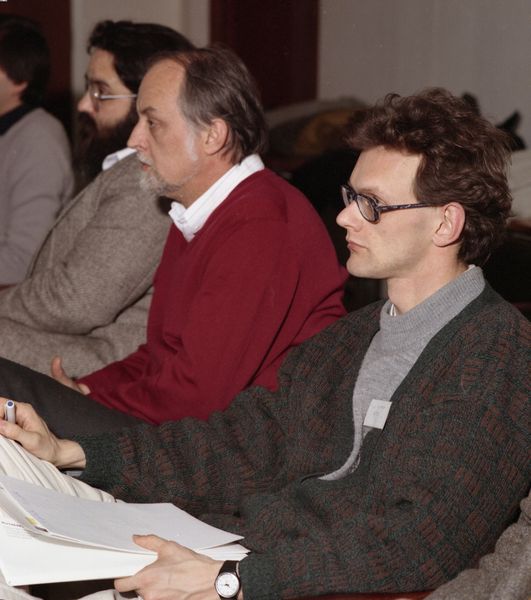
Ivan Herman and Paul ten Hagen
Full image ⇗
© UKRI Science and Technology Facilities Council
WebCore
- W3C Launched 1994
- October 1994: MIT Host: Al Vezza
-
December 1994: EC award INRIA WebCore Project to establish European Host
- December 1994 - January 1997
- To create a European
information market that improves the European economy and quality of life
- ERCIM agreed to help INRIA establish the European Host:
- GMD, CWI, RAL etc second staff to INRIA
- 1995: ERCIM EEIG joined W3C
- RAL, GMD, FORTH, CNR, SICS, .... also join
- W3C Early Deliverables:
- March 1995: INRIA Host: Jeff Abramatic
- May 1996; INRIA Host WWW5 in Paris with support from RAL
- PNG: October 1996
- PICS: October 1996
- CSS 1: December 1996
- HTML 3.2: January 1997
- Jigsaw and Amaya
- August 1996 Jeff Abramatic becomes Chairman of W3C
- European Commission will consider funding a follow up Project to raise awareness in Europe
but require it to have more partners than just INRIA
W3C-LA
- EC funded Leveraging Action: November 1997- March 1999
- WebCore had improved the web's basic infrastructure
- Need now was to increase European activity in Web marketplace
- Main Actions:
- Provide W3C Offices as National Points of Contact
- Raise awareness
- Offices to act as national W3C mirror sites
- Offices to encourage translations into local languages
- Offices to run Symposia and Workshops
- Encourage industry champions by developing shrink-wrapped demonstrators
-
Performance: Jigsaw implementation of HTTP 1.1
-
Content Design: CSS in Amaya
-
Trust: use PICS to label, rate and filter content
-
Europeanisation of the web via multi-lingual information services
-
Web Collections: a set of web pages that act as one
-
Synchronisation and Vector Graphics: SMIL, CGM and eventually SVG
- W3C's Jigsaw server and Amaya browser were the main infrastructure for the demonstrators
- Manager W3C-LA: Jeff Abramatic; Deputy Manager: Bob Hopgood
W3C-LA Project
- Initially considered ERCIM as the INRIA Partner in W3C-LA
- Eventually RAL was designated the partner
- ERCIM members to be W3C Office Sites
- Six European Offices established
- RAL, SICS, GMD, CWI, FORTH, CNR
- VTT were asked but declined
- SINTEF, SGFI, SZTAKI were ineligible
- Raise Awareness Early On:
- Literature
- Presence at Events
- Portable Stand
- Launch Offices
Leaflets

Leaflets
Full image ⇗
© UKRI Science and Technology Facilities Council
- Leaflets on Everything
- Standard 2-page format
- Translated into several languages
- Purchased set of portable holders
Portable Stand

Portable Stand
Full image ⇗
© UKRI Science and Technology Facilities Council
- W3C-LA Stand purchased by Josianne Roberts
- Travelled widely in Europe
- Material and Stand could be transported by one person
- Velcro blocks that could be organised to suit the occasion
October 1997 - April 1998
- 1-5 October 1997
- Infosys '97, Thessalonki
- 10-12 November 1997
- OpenNet '97, Berlin
- 24-28 November, 1997
- EITC '97, Brussels
- 3 December 1997
- RAL Office Opening, London
- 28 January 1998
- Web/CHI Event, Netherlands
- 19-25 March 1998
- CeBIT '98, Hanover
- 30 March 1998
- SICS Office Opening, Stockholm
- 1 April 1998
- GMD Office Opening, Bonn
- 2 April 1998
- CWI Office Opening, Utrecht
EITC '97
- 24-28 November 1997, Brussels
-
First major Conference presence
- Jeff Abramatic, Bob Hopgood, Martin Prime, Josiane Roberts set up stand
- Many W3C staff helped with demonstrations throughout the week
-
W3C Structured into three Domains:
- Architecture
- User Interface
- Trust and Society
-
Ran seven demonstrations:
- HTTP 1.1, CSS and Performance: Stephane Boyera
- XML/MathML: Content design: Vincent Quint and Irene Vatton
- PICS and trust: Daniel Dardailler
- Amaya and Europeanisation
- Web Collections
- SMIL: synchronisation: Martin Prime
- Vector Graphics: CGM and Web Schematics (later SVG): Roy Platon
UK Opening, 3 December 1997

Jeff Abramatic
Full image ⇗
© UKRI Science and Technology Facilities Council
- RSA: Royal Society for the Arts, Manufactures & Commerce
- Started in 1774
Programme
- Overview of W3C
- Jeff Abramatic
- Realising the Full Potential of the Web
- Tim Berners-Lee
- User Interface Domain
- Bert Bos
- Architecture Domain
- Philipp Hoschka
- Technology and Society
- Josef Dietl
UK OFFICE Opening, 3 December 1997: Speakers
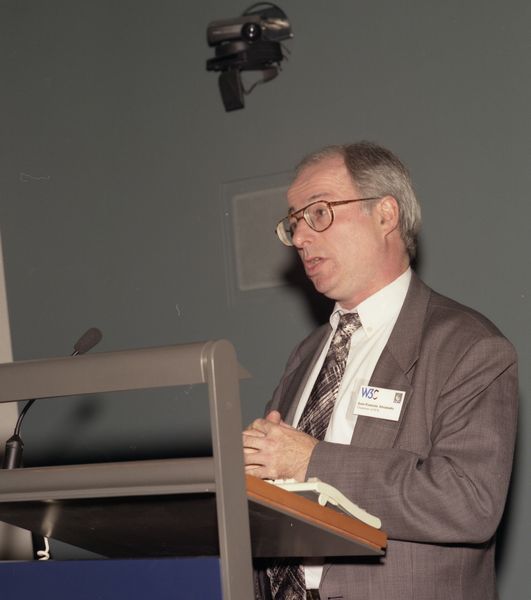
Jeff Abramatic
Full image ⇗
© UKRI Science and Technology Facilities Council

Bert Bos
Full image ⇗
© UKRI Science and Technology Facilities Council

Philipp Hoschka
Full image ⇗
© UKRI Science and Technology Facilities Council

Josef Dietl
Full image ⇗
© UKRI Science and Technology Facilities Council

Tim Berners-Lee
Full image ⇗
© UKRI Science and Technology Facilities Council
UK Office Opening, 3 December 1997: Demonstrations
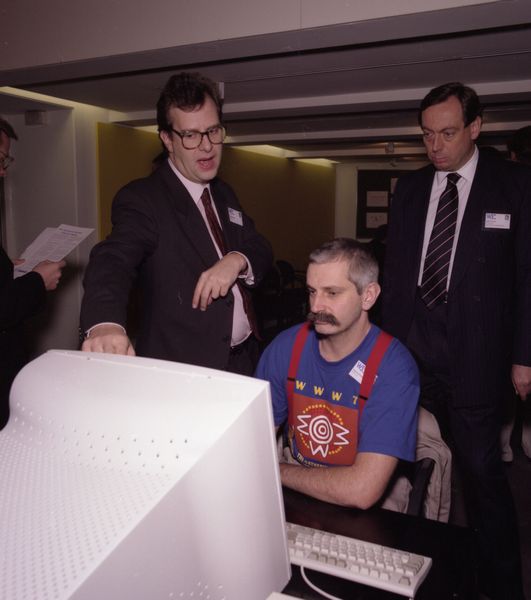
Michael Wilson, Martin Prime: SMIL
Full image ⇗
© UKRI Science and Technology Facilities Council

Ramzi Guetari: HTTP 1.1 and Jigsaw
Full image ⇗
© UKRI Science and Technology Facilities Council

Roy Platon: PNG and CGM
Full image ⇗
© UKRI Science and Technology Facilities Council
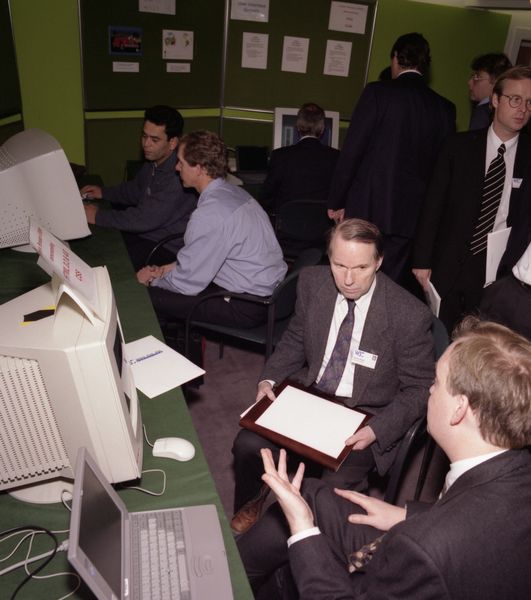
Brian Matthews: HTML 3.2 and CSS in Amaya
Full image ⇗
© UKRI Science and Technology Facilities Council
UK Office Opening, 3 December 1997: Attendees

Jeff Abramatic, Bert Bos, Robert Cailliau
Full image ⇗
© UKRI Science and Technology Facilities Council

John Reilly and Tim Berners-Lee
Full image ⇗
© UKRI Science and Technology Facilities Council

Martin Prime, Helen Ashman, Robert Cailliau, Brian Ritchie advertising WWW7 in Brisbane
Full image ⇗
© UKRI Science and Technology Facilities Council

Reading the literature
Full image ⇗
© UKRI Science and Technology Facilities Council
CeBIT '98
- March 19-25 1998 CeBIT, Hanover
- Organised by Klaus
- Part of GMD Stand
- Josef Dietl, Bob Hopgood, Rigo Wenning, Jose Kahan helped
Sweden: Office Opening, March 30, 1998

Kista Opening
Full image ⇗
© UKRI Science and Technology Facilities Council
- Electrum Building, Kista, Stockholm
- W3C had just launched WAI as a 4th Domain
- Robert Caillau and Judy Brewer gave the keynote talks
- Staff from INRIA and RAL helped with demonstrations
- All moved on to Bonn the next day
Germany: Office Opening, April 1, 1998
- Held at GMD Schloss, Birlinghoven, Sankt Augustin
- Trust and Society: PICS and Digital Signatures
- User Interface: HTML, DOM, CSS, Graphics, MathML
- Architecture: HTTP 1.1, XML, SMIL
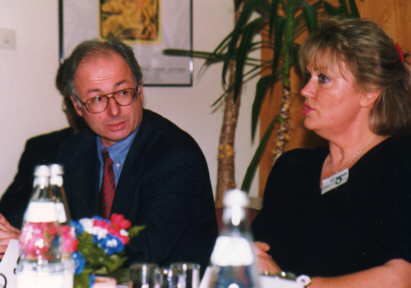
Jeff Abramatic, Scheutz

Klaus Birkenbihl, Robert Cailliau

Klaus, Robert, Josef Dietl

Schloss
Netherlands: Office Opening, April 2, 1998 with
Judy Brewer and Robert Cailliau the main speakers
W3C-LA
- Office activities continued throughout 1998
- Greece: Office Launch: Tutorials, September 1998
- Italy: Office Launch: April 1999
- Mirrors established at the European Offices of Germany, UK, Netherlands, Sweden, Greece
by Stephane Boyera
- MIT opened offices in Hong Kong and Taiwan. Both had W3C Mirrors
- W3C-LA Completed April 1999
W3C-LA Closing Event, December 1998
Major change in European awareness and the architecture of the Web over the life of W3C-LA
Programme
-
Overview of W3C: Josef Dietl
-
XML Update: Jon Bosask, Sun Microsystems
-
XML and Industrial Data: Tony Stewart (RivCom)
-
XML in News and Financial Information: Nic Fulton (Reuters)
-
RDF: the Resource Description Framework: Janne Saarela (W3C)
-
RDF in Digital Libraries: Stu Weibel (OCLC)
-
CSS and XSL: Hakon Lie (W3C)
-
CSS for WAI: Daniel Dardailler (W3C)
-
Vector Graphics on the Web: Chris Lilley (W3C)
-
SMIL: Multimedia on the Web: Michael Wilson (RAL)
-
TV on the Web: David Bradshaw (BBC)
-
The Future: Jeff Abramatic (W3C)
W3C-LA Closing Event, December 1998: Speakers

Jon Bosak: XML
Full image ⇗
© UKRI Science and Technology Facilities Council

Daniel Dardailler: WAI and CSS
Full image ⇗
© UKRI Science and Technology Facilities Council

Josef Dietl: W3C Overview
Full image ⇗
© UKRI Science and Technology Facilities Council
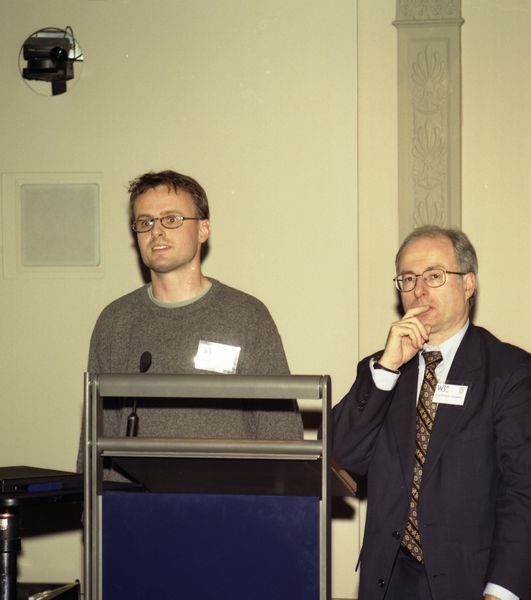
Hakon Lie: XSL and CSS
Full image ⇗
© UKRI Science and Technology Facilities Council

Chris Lilley: SVG, CGM and PNG
Full image ⇗
© UKRI Science and Technology Facilities Council
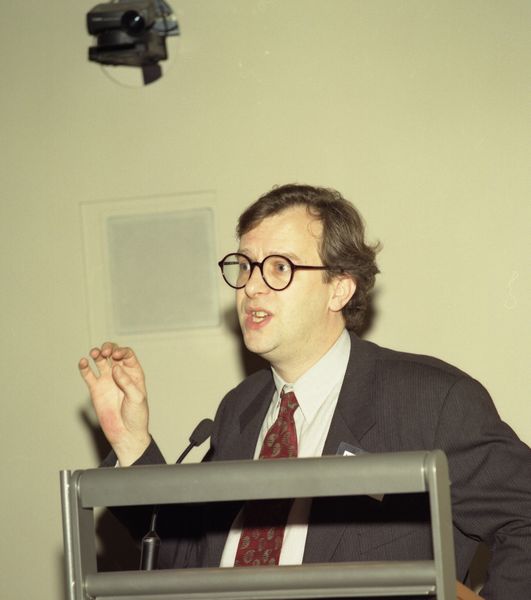
Michael Wilson: SMIL
Full image ⇗
© UKRI Science and Technology Facilities Council
W3C-LA Closing Event, December 1998: Demonstrations

Martin Prime: SMIL
Full image ⇗
© UKRI Science and Technology Facilities Council

David Duce: Vector Graphics
Full image ⇗
© UKRI Science and Technology Facilities Council

RivCom: XML and Industrial Data
Full image ⇗
© UKRI Science and Technology Facilities Council
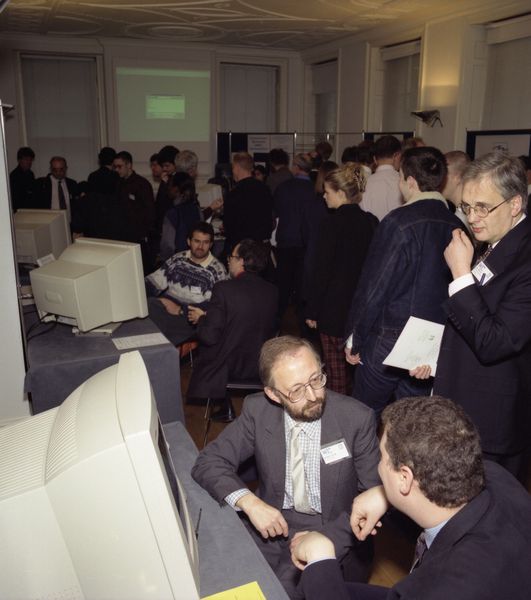
Steve Cook: Workflow and RDF
Full image ⇗
© UKRI Science and Technology Facilities Council

Jose Kahan: HTTP 1.1 and Jigsaw
Full image ⇗
© UKRI Science and Technology Facilities Council

Daniel Dardailler: Accessibility
Full image ⇗
© UKRI Science and Technology Facilities Council
Was W3C-LA Successful?
| Growth in Internet Users |
| Country |
Internet Users (Millions) |
| With Offices |
| UK |
13.975 |
| Germany |
12.285 |
| France |
5.696 |
| Sweden |
3.950 |
| Netherlands |
2.933 |
| Without Offices |
| Finland |
1.430 |
| Belgium |
1.400 |
| Norway |
1.340 |
| Switzerland |
1.179 |
| Growth in W3C Affilate Membership (%) |
| USA |
80 |
| Europe |
160 |
And the rise was mainly in European countries with Offices
After W3C-LA
- Josef Dietl took over running the Offices once they were established
- MIT Offices: Hong Kong and Taiwan
- W3C-LA Offices: UK, Sweden, Germany, Netherlands, Greece, Italy
- I ran the UK Office during 1999 before I retired from RAL early in 2000
- Josef Dietl resigned and I joined W3C to run the Offices
- W3C were keen on expanding the coverage of the Offices particularly where they broadened W3C's Internationalisation expertise and outreach
- I opened Offices in Israel, Australia, Morocco
- Eurographics 2000: Interlaken, 20-25 August 2000
- Talked to Ivan Herman who was seeking a new challenge
- Ivan took over from me at the end of 2000
-
Ivan Herman: 2001-2006
- Korea, Hungary, Finland, Spain, India
-
2006-2008: Daniel Dardailler, Klaus Birkenbihl
QUESTION-HOW
- A follow on to W3C-LA
- The world's worst acronym: I apologise!
-
QUality
Engineering
Solutions via #
Tools,
Information and
Outreach for the
New
Highly-enriched
Offerings from
W3C: Evolving the Web in Europe
- EC was happy to consider a follow on to W3C-LA
- Better European coverage
- Move into Eastern Europe
- Develop useful tools
- Allow companies to make mission-critical decisions with regard to the Web
- Inform Europe of emerging technologies
- The Web had changed significantly since the start of W3C-LA:
- XML replacing HTML for Web Content
- Access devices broadening: PDAs, mobile phones, TV, cookers and refrigerators
- Metadata as an aid to searching becoming important
- Modularisation of standards to allow negotiation
- Generic XML-based applications: MathML, SMIL, SVG, CML etc
- A richer and improved interaction model
QUESTION-HOW: Euro Speak
- WP1: Helping Companies Develop Mission Critical Solutions of Quality in a Complex and Rapidly Changing Environment
- WP2: Provide Additional Tools to Support New Technologies
- WP3: Extend Outreach of Existing Offices
- WP4: New European Offices
- WP5: Infrastructure for Informed Decisions
- WP6: European Events
- WP7: Project Management
QUESTION-HOW: W3C Speak
- WP1: CSS and XHTML Validators, Robust Tidy, SirPAC (RDF), SVG Test Suite
- WP2: SMIL 2, XHTML, Mobile, RDF, XSLT awareness. Work on XForms, XEvents and Web Services
- WP3:
- Germany becomes Austria, Switzerland and Germany,
- UK becomes UK and Ireland,
- Netherlands becomes Benelux,
- Sweden becomes Scandinavia,
- Italy becomes Italy and Italian-speaking Switzerland etc
- WP4: Add Hungary, Spain or Portugal, possibly Finland and one other Eastern European
- WP5: Presentations, Handouts, Case Studies, Stand Material, New Demonstrators
- WP6: Interoperabilty (Mobile and XML-interworking) and Semantic (XML Schemas and RDF) Web Tours
- WP7: Organise and Report back
QUESTION-HOW
- Agreed with Commission in Brussels
- Jeff Abramatic, Bob Hopgood, Philipp Hoschka, Ivan Herman
- I handed over to Ivan Herman
- September 2001 - September 2003
- Offices involved: UK, Germany, Netherlands, Italy, Greece, Israel, Sweden
- Regionalisation
- New Offices: Finland, Spain and Hungary
- 2002: European Interop Tour: Paris, Vienna, Dublin, Brussels
- 2003: Semantic Tour: Rome, London, Munich, Athens, Brussels
- Deliverables
- HTML and CSS Validators
- Tidy
- SVG Benchmark
- Start the move of the W3C Host to ERCIM
Office Successes
- Raised Awareness
- Raised Membership
- Supported existing W3C Members
- Major contribution to I18N: websites, translations, etc
- Improved the infrastructure: demonstrators, validators, test suites, etc
- Contributed to standards: SMIL, SVG, CGM, XML, RDF, PICS, HTML, PNG, Accessibility, mobile web, etc
- 1994-2001 was an interesting period ;-)




































